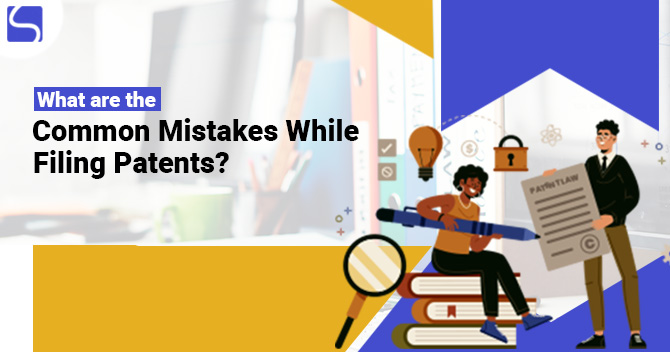What are the Common Mistakes While Filing Patents?

Karan Singh | Updated: Oct 23, 2021 | Category: Patent
For a tech-based company or business, if you want to protect and commercialise the invention, then filing applications for Patent Registration is a vital step. But, in the course of a long and expensive filing process, it is easy to make mistakes while filing Patents, especially if you don’t have any experience managing a Patent Portfolio. Many companies rely on the IP Portfolio of their company in which Patents play an essential role. Even a well-researched & careful attempt to file a Patent can run into unexpected mistakes. In simple words, mistakes while filing Patents can be ruinous to the company. Scroll down to check the common mistakes while filing Patents.
Table of Contents
What is a Patent?
Before we discuss the common mistakes while filing Patents, let’s first understand the meaning of Patents. A Patent is a special right granted for an invention, which is a product or a process that gives a new way of doing something unique or provides a new technical solution to a problem. To obtain a Patent, technical details of the invention should be revealed to the public in a Patent application. Patent protection means that the invention can’t be commercially made, distributed, used, sold, or imported by others without the Patent owner’s permission. The Patent Registration is granted for a limited time, usually twenty years from the date of filing a Patent application.
If anyone wants to file a Patent internationally, then the PCT or Patent Cooperation Treaty allows you to make a sole international Patent application that has a similar effect as national applications filed in separate PCT states. In a nutshell, you benefit from a single application in one language paid for in one currency. So after discussing the meaning of Patents, now let’s move towards common mistakes while filing Patents.
Common Mistakes While Filing Patents
Here is what you need to remember in mind in order to avoid the common mistakes while filing Patents:
- Don’t Just Patent a Simple Idea: The invention should be provided in a physical framework, or the Patent application, including the invention, should be filed with the Patent & Trademark Office concerned (preferably US Patents & Trademarks – USPTO). While all ideas begin with an idea, only one out of each odd idea can be called innovation or invention. The Patent concept should be innovative, unique, and valuable.
- Not Using NDA: Think of a world without an enforceable NDA (Non-Disclosure Agreement), where you cannot reveal a confidential workpiece. It will be very discouraging to reveal confidential details, with all the risk & loss of all the creative work being done.
- Not Looking for Prior Art: Prior art is something present in the public domain prior to the invention of an inventor. This art could be published Patents, published pending applications and openly available Non-Patent Literature. When the inventor submits the application to the Patent Office, the examiner carries out a Patent Search to estimate the invention’s patentability.
- Not taking benefits of Provisional Patent Applications: Sometimes, the invention may not have matured into a final form or maybe at an initial stage. Or, the inventor or originator may only have the idea but doesn’t have the means to execute it. The inventor does not need to wait for the invention to mature or until the idea is executed to file for Patent Registration.
- Filing an Incorrectly Drafted Patent Application: Due to the lack of knowledge or in a hurry to file Patent applications, inventors often submit Patent applications that don’t meet the requirements of law. This is one of the common mistakes inventors commit while filing Patent applications. So to avoid this mistake, the Patent application should explain the information on how each & every aspect of the invention works to solve the underlying technical issue. The Patent application should be provided in such a way that an individual skilled in the art will be liable to execute the invention by reading the description provided, with logical experimentation. The inventor or originator may make use of drawings to explain how the invention works. Moreover, the claims in the application should define the invention’s boundary and should be clear.
- Search for Other Options for Patent Search Apart from Google: The invention is patentable when you are the first one who comes up with this invention in a country or the world. You must promise that you are the only parent of the idea.
To conduct a Patent Search, the first thing that comes to mind is Google, but the internet is not a trustworthy database to run a Patent Search. It’s likely that many Patent applications have been rejected but are still on the internet. Second, it may not be clear whether a present that recognises your innovation covers your creation or not. Third, as an inventor, you need to support impartially. As you scan & read Patents that are linked with your invention, you may be influenced by what by reading, taking a chance with the distinctiveness of your creativity.
- Don’t Submit an Unclear Application: The USPTO[1] has very severe rules for Patent applications & you will face automatic rejection if you don’t correctly follow such rules. Your Patent Drawings are the simplest part of a Patent, but if the Patent application is not submitted correctly, a 1st-time candidate might face rejections. For your application, it is better to employ Patent Attorneys because they know the rules & can guarantee that your application is not refused for silly mistakes.
- Don’t be Ultimate with your Submission: Before pushing your product or service to people, you will probably invest time testing its usefulness & plan of action while gathering input from examiners. This is an essential step in the process of creativity. When you have distinguished your creation, work in parallel to file a Patent application. It’s vital to remember that you are only granted one year after your innovation is first publicly disclosed for the purpose of filing an application, after which the idea is not safeguarded.
Conclusion
After discussing common mistakes while filing Patents, it is clear that the process of filing Patent applications requires careful examination as it is a one-time process that must be comprehensive and punctual. When considering filing a Patent application, it’s always better to be aware of Patent Law or involve a Patent Attorney to get an idea regarding understanding the law and the process of filing a Patent application.
Read our article:What are the Advantages & Disadvantages of the Patent Cooperation Treaty (PCT)?














